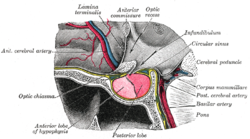Hypothalamo-pituitary portal system
| Hypophyseal portal system | |
|---|---|
 |
|
| Details | |
| Identifiers | |
| Latin | Venae portales hypophysiales |
|
Anatomical terminology
[]
|
|
The hypophyseal portal system is a system of blood vessels in the microcirculation at the base of the brain, connecting the hypothalamus with the anterior pituitary. Its main function is to quickly transport and exchange hormones between the hypothalamus arcuate nucleus and anterior pituitary gland. The capillaries in the portal system are fenestrated (have many small channels with high vascular permeability) which allows a rapid exchange between the hypothalamus and the pituitary. The main hormones transported by the system include gonadotropin-releasing hormone, corticotropin-releasing hormone, growth hormone–releasing hormone, and thyrotropin-releasing hormone.
The blood supply and direction of flow in the hypophyseal portal system has been studied over many years on laboratory animals and human cadaver specimens with injection and vascular corrosion casting methods. Short portal vessels between the neural and anterior pituitary lobes provide an avenue for rapid hormonal exchange. Specifically within and between the pituitary lobes is anatomical evidence for confluent interlobe vessels, including venules providing blood from the anterior to the neural lobe, and capillary shunts exchanging blood between the intermediate and neural lobes. Such microvascular structures indicate moment-to-moment streams of information between lobes of the pituitary gland.
Results of other studies showed that the neural hypophyseal stalk and ventromedial region of the hypothalamic arcuate nucleus receive arterial blood from ascending and descending infundibular branches and capillaries, coming from arteries of the superior hypophyseal arterial system. Small ascending vessels arising from the anastomoses that connect the upper with the lower hypophyseal arterial system also supply blood to hypophyseal vessels. Many of these branches are continuous between the proximal arcuate nucleus and anterior pituitary, enabling rapid hormone exchange. Other evidence indicates that capillary perivascular spaces of the median eminence and arcuate nucleus are contiguous, potentially facilitating hormonal messages between systemic blood and the ventral hypothalamus.
...
Wikipedia
